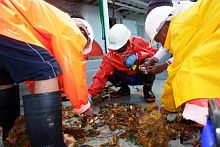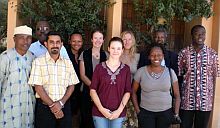SAEON Egagasini Node coordinates data for ASCLME project
|
The Agulhas Somali Current Large Marine Ecosystem project (ASCLME) is aimed at undertaking an environmental baseline assessment of the Agulhas and Somali Current Large Marine Ecosystems with a view to developing a Transboundary Diagnostic Analysis (TDA) and Strategic Action Programme.
Funded by the Global Environment Facility and implemented by the United Nations Development Programme, the ASCLME will run over the next four years, with work ongoing after this period. The eight participating countries are the Comoros, Kenya, Madagascar, Mauritius, Mozambique, Seychelles, South Africa and Tanzania (and Somalia where possible).
The ASCLME encourages and assists these countries to work together in an effort to manage the marine and coastal resources of the Western Indian Ocean. An ‘ecosystem approach’ has been adopted, highlighting the human needs at the focus of biodiversity management and the optimal utilisation of the ecosystem without degrading it.
Main objectives
The project has four main objectives. The first is to establish long-term data collection, management and distribution mechanisms for the western Indian Ocean region, in order to gather new information about the Agulhas and Somali Currents and how they interact with and influence the climate, biodiversity and economies of the region.
The second is to capture information for development of the TDA, bearing in mind the five TDA modules - Fish and Fisheries; Productivity; Ecosystem Health and Pollution; Socioeconomics; Management and Governance.
The third is to develop a Strategic Action Programme and associated sustainability mechanisms adopted for a Large Marine Ecosystem (LME) approach (based on the last two TDA modules). The final objective is LME coordination, communication and participation mechanisms established, strengthening scientific and management expertise.
There are three projects that make up the Agulhas Somali Current Large Marine Ecosystem project - the ASCLME; the South West Indian Ocean Fisheries Project (a multinational project that is building knowledge for managing industrial fisheries); and addressing land-based activities (including sources of pollution) in the Western Indian ocean region.
The project has a national and regional structure. Each of the countries has an ASCLME national focal point. In South Africa’s case, this is at Marine and Coastal Management - MCM (aside from the principal coordination unit which is based in Grahamstown).
Data and Information Coordinator for South Africa
Each country has set up a national coordination group consisting of a Cruise Coordinator, Data and Information Coordinator and Capacity Building Coordinator. Dr Juliet Hermes, Manager of SAEON’s Egagasini Node was nominated as the Data and Information Coordinator for South Africa by the South African focal institute, MCM.
She was tasked with coordinating all national activities in support of sourcing, gathering, reviewing, compiling and reporting on data and information required for the Marine Ecosystem Diagnostic Analyses (MEDA), which will feed into the regional TDA and strategic action programme. Sue Matthews, an environmental science writer and editor, has been working closely with Juliet to coordinate and complete different sections of the MEDA.
The MEDA consists of descriptions, areas of concern, gaps and metadata tables of the biophysical environment, human environment, economy, policy and governance as well as planning and management. There is also an exhaustive bibliography on which a number of students have been working.
As part of this work, Juliet has attended a number of meetings with the other data and information coordinators, which has allowed for useful networking and relationship building with East African countries. These included the first regional meeting of the Data and Information technical group (29 September -1 October 2008 in Mauritius); the second (9-13th February 2009 in Grahamstown); and third (20-21 August, 2009 on Reunion Island).
SAEON’s Egagasini and Elwandle teams have also been involved in one of the ASCLME cruises
The first draft of the MEDA is almost complete. The MEDA will undergo a number of reviews and will eventually be made publicly available. Further details can be found on the website www.asclme.org or by contacting Juliet.












